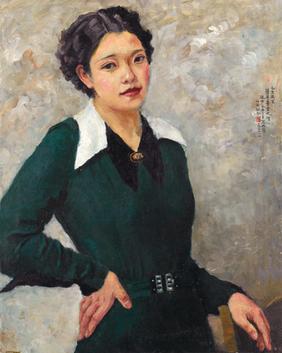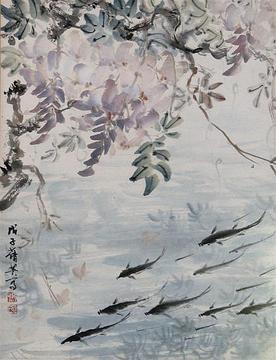Chien-Ying Chang facts for kids
Quick facts for kids
Chien-Ying Chang
|
|
|---|---|

Self-portrait (1936)
|
|
| Born | May 25, 1913 |
| Died | January 2004 (aged 90) London
|
| Nationality | Chinese |
| Education |
|
| Known for | Oil painting, Chinese ink painting |
Chien-Ying Chang (born May 25, 1913, in Wuxi, China – died January 2004) was a talented Chinese artist. She was known for her beautiful paintings, using both traditional Chinese ink and Western oil techniques. Chien-Ying Chang moved to Britain in 1946 and lived there for over 50 years. She became famous for her unique art style, blending Chinese and British influences.
Early Life and Art Training
Chien-Ying Chang was born in Wuxi, China. Her father worked for the customs department. After finishing secondary school, she decided to study art. From 1931 to 1935, she attended Nanjing University to learn painting.
While at Nanjing, she met Cheng-Wu Fei, who would later become her husband. A famous artist named Xu Beihong inspired her. He had studied Western painting in London after the First World War. Xu Beihong encouraged Chien-Ying to also study art in Europe.
In 1947, Chien-Ying and Cheng-Wu Fei received special grants from the British Council. This allowed them to travel to Britain. They both enrolled at the Slade School of Art in London. There, they learned from well-known teachers like Randolph Schwabe and William Coldstream.
Life and Art in Britain
After their studies, Chien-Ying Chang and Cheng-Wu Fei decided to stay in Britain. This was because the new government in China had different ideas about art. They lived in Britain for about 50 years. Their art was shown in many important places. These included the Royal Academy of Arts, the Royal Society of Painters in Watercolours, and the Society of Women Artists.
Their work quickly caught the eye of famous people. The painter Stanley Spencer admired their art. Even Mrs. Clement Attlee, whose husband was the Prime Minister, was interested. Stanley Spencer was even at Chien-Ying and Cheng-Wu's wedding in 1953. He painted several pictures of Chien-Ying. In return, Cheng-Wu Fei painted Spencer.
The couple loved the British landscape. They found its rain and scenery reminded them of China. Chien-Ying Chang often visited places like the Lake District and Devon. She created paintings there that had a special Chinese feel. She often used traditional rice paper, which gave her art a delicate look. They bought a house in Finchley, north London. They filled their garden with plants from Asia. Inside, Chien-Ying Chang painted beautiful landscape murals on the walls.
Creative Design Work
While her husband focused on teaching art, Chien-Ying Chang explored many creative paths. She traveled around Britain, showing people how to do traditional Chinese painting. She also shared her cooking skills at Kenneth Lo's Chinese cookery school. She even appeared on his TV show, 'The Taste of China'.
Chien-Ying Chang was also a skilled calligrapher. This means she was very good at artistic handwriting. Her delicate brush strokes, used in her paintings, came from this skill. Because of this, she was asked to illustrate many books of poems. She also helped design sets for movies about China.
She painted street signs and helped with costume design for films. These included The Inn of the Sixth Happiness and The World of Suzy Wong. Her work for The Road to Hong Kong led to a friendship with the American comedian Bob Hope. She also designed a beautiful silk pattern with swallows for the famous fashion designer Christian Dior. Chien-Ying Chang even sang in Peking Opera shows, performing both male and female roles.
In her later years, she became well known for a series of prints. These prints featured birds and landscapes and were popular in many homes. Her art was even part of the painting event at the 1948 Summer Olympics art competition. After her husband passed away, she visited Shanghai. She found that her hometown had changed so much she hardly recognized it.


